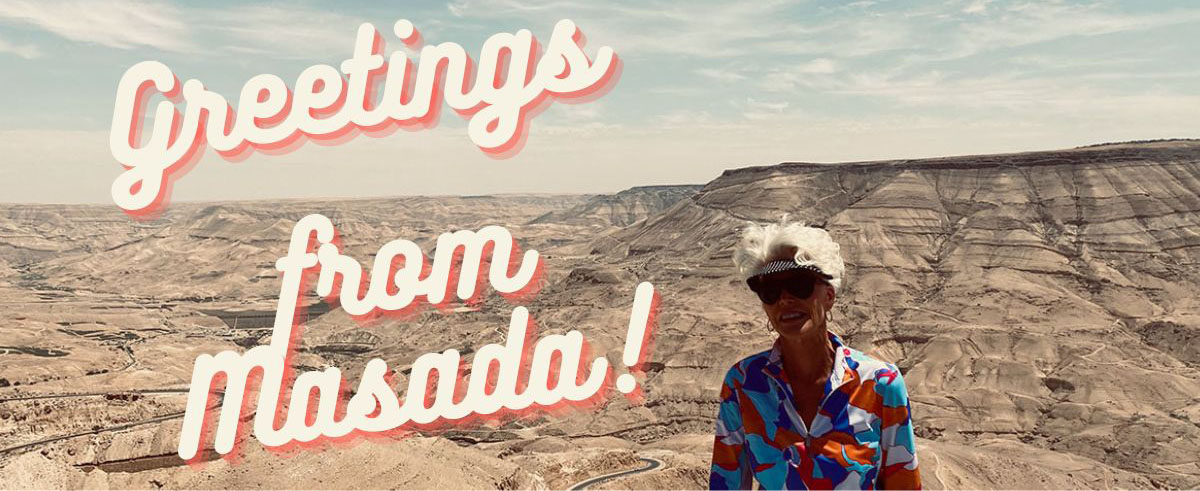The Dead Sea: Masada, Magic Mud and Pickle Juice

The Dead Sea is a place of riveting natural beauty and murderous weather extremes. Ragged cliffs, arid canyons where dust storms flare and blur the landscape in a palette of opaque cobalt and shadow for hours. Leaving the visitor feeling coated in a layer of finely ground glass. It’s the Lowest. Place. On. Earth. A fact you can’t miss given the signage. It’s also the place humans have somehow inhabited for millennia. And built extraordinary architectural masterpieces like Herod’s Masada and Qumran where the Dead Sea Scrolls were found. Today, the coastline is lined with luxury hotels, each boasting the latest, greatest, expensive and most luxurious accommodations for the spa-seeking visitor.

I visited the fabled Sea on both shores, the Israeli and the Jordanian and had opportunities to visit the beaches and soak in the mineral-rich, muddy bottomed waters of each coastline.
Where to Go, What to Do
Float: You can do this at Ein Bokek Beach. This activity is, in the opinion of this traveling broad, highly overrated. Beach access can be treacherous due to the slippery mud-covered rocks that line the shore and entry into deeper waters is a must. The Dead Sea has no tide (since it’s really a lake, not a sea) but waters can be rough if its windy. Also, it’s takes a leap of faith to pop over onto your back. You can’t swim, you absolutely can’t open your eyes underwater, and once horizontal it’s hard to return to a vertical position.



I’m reasonably fit for my age but I needed help from fellow bathers to get my legs back beneath me! Wear sandals or water shoes to assist with that treacherous footing and plan to throw them away after one dip in the Sea. The salinity is overpowering. It took two thoroughly soaped showers to remove the salty residue from my skin.
Honestly, the water felt and smelled like I was bathing in oily pickle juice, (if that were an option). Briny and noxious. But okay, I swam in the Dead Sea. Check.
Now the skincare products from the region are another subject. Read on.
Magic Mud and Your Skin
Legend has it that Cleopatra soaked in its waters for the restorative and purifying benefits, using mud from the Dead Sea for her skin care. Spa-based hotels line the shore offering a variety of luxury treatments, most of which include soaking in its waters and treatments with products made from the region’s mineral-packed mud.
My personal find was an amazing line of skincare products, especially the mud-based masks which I brought back as gifts for my daughters and daughters-in law. My splurge was the Ahava moisturizing creams. Love them! Ahava Dead Sea Laboratories is an Israeli cosmetics company that manufactures skin care products made of mud and mineral-based compounds from the Dead Sea.

How does it work? No one is certain…at least that’s what I’ve found after hours of online research, but there are “opinions”.
The lake boasts high concentrations of magnesium, sodium, phosphates, bromides and other minerals thought to improve skin conditions as well as certain heart and lung conditions, hydrate the skin and reduce roughness and inflammation.
Dead Sea Research Center
So the short story is that the “magic mud” does wonders for your skin. Now on to another of the region’s highlights.
Israel’s Iconic Site
Masada is magnificent. Imagine life during the thousand day hold-out by Jewish rebels and the final Roman siege. The fortress, built by King Herod in 30 BCE was where they made a last stand against their invader, choosing to commit mass suicide rather than fall to their captors. The most impressive structure remaining is King Herod’s northern palace, built on three rock terraces overlooking the gorge below.


The most dramatic way to view this natural wonder is via cable car, relatively inexpensive at about $25 round trip inclusive of entrance to the site.
The palace on the northern face of the dramatic mountain site consists of an exceptional group of classical Roman Imperial buildings. The water system was particularly sophisticated, collecting runoff water from a single day’s rain to sustain life for a thousand people over a period of two to three years. This achievement allowed the transformation of a barren, isolated, arid hilltop into a lavish royal retreat.
This is a site that remained untouched for more than thirteen centuries. The buildings and other evidence of human settlement gradually collapsed and were covered over until they were revealed in the 1960s. There have been no additions or reconstruction and inappropriate materials used in early conservation projects are being replaced. Limited restoration works have been carried out to aid visitor interpretation with original archaeological levels being clearly defined by a prominent black line set in the new mortar joints. Certain significant archaeological elements, such as the Roman camps and siegeworks, remain virtually untouched. The authenticity is therefore of a very high level.
From the Unesco World Heritage Site
It’s singularly impressive and worthy of a day-long visit. Pack your sunscreen, a visor and a water bottle or two!

Related Posts
Twelve Fascinating Facts You Didn’t Know About Victoria Falls
My Zimbabwe adventure included a morning hike in the Victoria Falls Rainforest and an afternoon …
February 22, 2024Blue is the Color! Iceland’s Monumental Glaciers
Filling the valley between the mountains with blue-white light. Vatnajökull Glacier in Iceland is the …
August 9, 2023

Leave A Comment